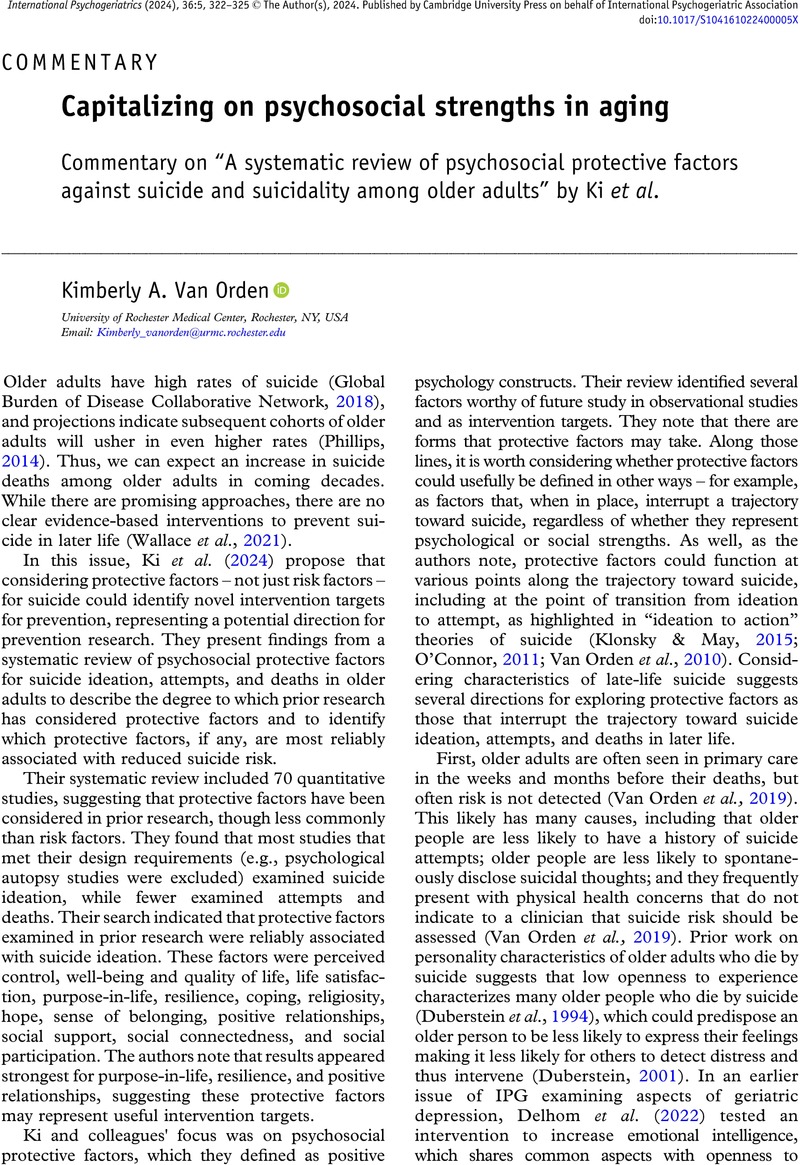No CrossRef data available.
Article contents
Capitalizing on psychosocial strengths in aging
Commentary on “A systematic review of psychosocial protective factors against suicide and suicidality among older adults” by Ki et al.
Published online by Cambridge University Press: 22 January 2024
Abstract
An abstract is not available for this content so a preview has been provided. Please use the Get access link above for information on how to access this content.

Information
- Type
- Commentary
- Information
- International Psychogeriatrics , Volume 36 , Special Issue 5: Issue Theme: Suicide in Older Adults , May 2024 , pp. 322 - 325
- Copyright
- © The Author(s), 2024. Published by Cambridge University Press on behalf of International Psychogeriatric Association
References
Global Burden of Disease Collaborative Network. (2018). Global Burden of Disease Study 2017 (GBD 2017) Results.Google Scholar
Phillips, J. A. (2014). A changing epidemiology of suicide? The influence of birth cohorts on suicide rates in the United States. Social Science & Medicine, 114C, 151–160. https://doi.org/10.1016/j.socscimed.2014.05.038
CrossRefGoogle Scholar
Wallace, M., Miller, V. J., Fields, N. L., Xu, L., & Mercado-Sierra, M. A. (2021). Empirically evaluated suicide prevention program approaches for older adults: A review of the literature from 2009–2021. Journal of Gerontological Social Work, 64(5), 1–19. https://doi.org/10.1080/01634372.2021.1907495
CrossRefGoogle ScholarPubMed
Ki, M., Lapierre, S., Gim, B., Hwang, M., Kang, M., Dargis, L., Jung, M., Koh, E., & Mishara, B. (2024). A systematic review of psychosocial protective factors against suicide and suicidality among older adults. International Psychogeriatrics.CrossRefGoogle ScholarPubMed
Klonsky, E. D., & May, A. M. (2015). The three-Step Theory (3ST): A new theory of suicide rooted in the, ideation-to-action, framework. International Journal of Cognitive Therapy, 8(2), 114–129.CrossRefGoogle Scholar
Van Orden, K., Witte, T., Cukrowicz, K., Braithwaite, S., Selby, E., & Joiner, T. (2010). The interpersonal theory of suicide. Psychological Review, 117(2), 575–600. https://doi.org/10.1037/a0018697
CrossRefGoogle ScholarPubMed
O’Connor, R. C. (2011). The integrated motivational-volitional model of suicidal behavior. Crisis, 32(6), 295–298. https://doi.org/10.1027/0227-5910/a000120
CrossRefGoogle ScholarPubMed
Van Orden, K. A., Silva, C., & Conwell, Y. (2019). Suicide in later life. In Knight, B. (Ed.), Oxford Research Encyclopedia of Psychology (Psychology and Aging). Oxford University Press.Google Scholar
Duberstein, P. R., Conwell, Y., & Caine, E. D. (1994). Age differences in the personality characteristics of suicide completers: Preliminary findings from a psychological autopsy study. Psychiatry: Interpersonal and Biological Processes., 57(3), 213–224.CrossRefGoogle ScholarPubMed
Duberstein, P. R. (2001). Are closed-minded people more open to the idea of killing themselves? Suicide and Life-Threatening Behavior, 31(1), 9–14.CrossRefGoogle Scholar
Delhom, I., Meléndez, J. C., & Satorres, E. (2022). Emotional intelligence intervention in older adults to improve adaptation and reduce negative mood. International Psychogeriatrics 34(1), 79–89. https://doi.org/10.1017/S1041610220003579
CrossRefGoogle ScholarPubMed
Cha, C. B., & Nock, M. K. (2009). Emotional intelligence is a protective factor for suicidal behavior. Journal of the American Academy of Child & Adolescent Psychiatry, 48(4), 422–430. https://doi.org/10.1097/CHI.0b013e3181984f44
CrossRefGoogle ScholarPubMed
Charles, S. T., & Carstensen, L. L. (2010). Social and emotional aging. Annual Review of Psychology., 61(1), 383–409. https://doi.org/10.1146/annurev.psych.093008.100448,CrossRefGoogle ScholarPubMed
Duberstein, P. R., Conwell, Y., Conner, K. R., Eberly, S., Evinger, J. S., & Caine, E. D. (2004). Poor social integration and suicide: Fact or artifact? A case-control study. Psychological Medicine, 34(7), 1331–1337.CrossRefGoogle ScholarPubMed
Stone, D. M., Simon, T. R., Fowler, K. A., Kegler, S. R., Yuan, K., Holland, K. M., Ivey-Stephenson, A. Z., & Crosby, A. E. (2018). Vital signs: Trends in state suicide rates - United States, 1999-2016 and circumstances contributing to suicide - 27 states, 2015. Morbidity and Mortality Weekly Report, 67(22), 617–624. https://doi.org/10.15585/mmwr.mm6722a1
CrossRefGoogle Scholar
Tsai, A. C., Lucas, M., & Kawachi, I. (2015). Association between social integration and suicide among women in the United States. JAMA Psychiatry, 72(10), 987. https://doi.org/10.1001/jamapsychiatry.2015.1002
CrossRefGoogle ScholarPubMed
Tsai, A. C., Lucas, M., Sania, A., Kim, D., & Kawachi, I. (2014). Social integration and suicide mortality among men: 24-year cohort study of U.S. health professionals. Annals of Internal Medicine, 161(2), 85–95. https://doi.org/10.7326/M13-1291
CrossRefGoogle ScholarPubMed
Chu, C., Buchman-Schmitt, J. M., Stanley, I. H., Hom, M. A., Tucker, R. P., Hagan, C. R., Rogers, M. L., Podlogar, M. C., Chiurliza, B., Ringer, F. B., Michaels, M. S., Patros, C. H. G., & Joiner, T. E. (2017). The interpersonal theory of suicide: A systematic review and meta-analysis of a decade of cross-national research. Psychological Bulletin, 143(12), 1313–1345. https://doi.org/10.1037/bul0000123
CrossRefGoogle ScholarPubMed
Zuidersma, M., Lugtenburg, A., van Zelst, W., Reesink, F. E., De Deyn, P. P., Strijkert, F., Zuidema, S. U., & Oude Voshaar, R. C. (2022). Temporal dynamics of depression, cognitive performance and sleep in older persons with depressive symptoms and cognitive impairments: A series of eight single-subject studies. International Psychogeriatrics., 34(1), 47–59. https://doi.org/10.1017/S1041610221000065
CrossRefGoogle ScholarPubMed

